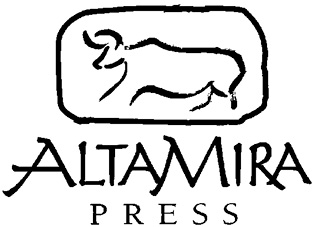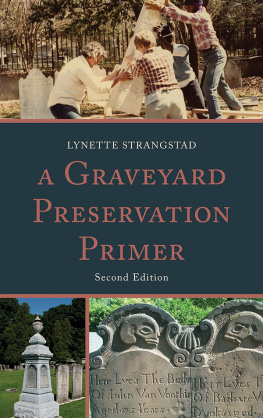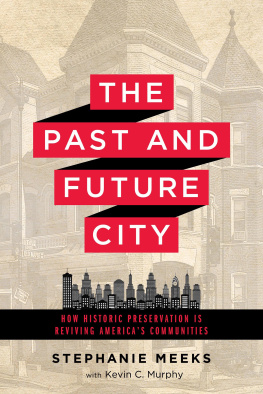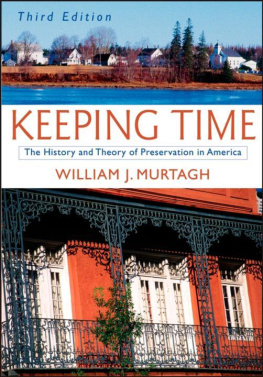A Graveyard Preservation Primer
AMERICAN ASSOCIATION FOR STATE AND LOCAL HISTORY BOOK SERIES
Publications Chair
Russell Lewis, Chicago History Museum
Editorial Advisory Board
Norman O. Burns, II, Maymont Foundation
Jessica Dorman, The Historic New Orleans Collection
Garet D. Livermore, The Farmers Museum
Brenden Martin, Middle Tennessee State University
Thomas A. Mason, Indiana University-Purdue University Indianapolis
Eloise Batic, Indiana Historical Society
Ellen Spear, Heritage Museums & Gardens
Ann Toplovich, Tennessee Historical Society
Barbara B. Walden, Community of Christ Historic Sites Foundation
About the Series
The American Association for State and Local History Book Series publishes technical and professional information for those who practice and support history, and addresses issues critical to the field of state and local history. To submit a proposal or manuscript to the series, please request proposal guidelines from AASLH headquarters: AASLH Book Series, 1717 Church St., Nashville, Tennessee 37203. Telephone: (615) 320-3203. Fax: (615) 327-9013. Website: www.aaslh.org.
About the Organization
The American Association for State and Local History (AASLH), a national history organization headquartered in Nashville, TN, provides leadership, service, and support for its members, who preserve and interpret state and local history in order to make the past more meaningful in American society. AASLH is a membership association representing history organizations and the professionals who work in them. AASLH members are leaders in preserving, researching, and interpreting traces of the American past to connect the people, thoughts, and events of yesterday with the creative memories and abiding concerns of people, communities, and our nation today. In addition to sponsorship of this book series, the Association publishes the periodical History News , a newsletter, technical leaflets and reports, and other materials; confers prizes and awards in recognition of outstanding achievement in the field; and supports a broad education program and other activities designed to help members work more effectively. To join the organization, go to www.aaslh.org or contact Membership Services, AASLH, 1717 Church St., Nashville, TN 37203.
A Graveyard Preservation Primer

Lynette Strangstad

AltaMira Press
A Division of Rowman & Littlefield Publishers, Inc.
Lanham New York Toronto Plymouth, UK
Published by AltaMira Press
A division of Rowman & Littlefield Publishers, Inc.
A wholly owned subsidiary of The Rowman & Littlefield Publishing Group, Inc.
4501 Forbes Boulevard, Suite 200, Lanham, Maryland 20706
www.rowman.com
10 Thornbury Road, Plymouth PL6 7PP, United Kingdom
Copyright 2013 by AltaMira Press
All rights reserved . No part of this book may be reproduced in any form or by any electronic or mechanical means, including information storage and retrieval systems, without written permission from the publisher, except by a reviewer who may quote passages in a review.
British Library Cataloguing in Publication Information Available
Library of Congress Cataloging-in-Publication Data
Strangstad, Lynette.
A graveyard preservation primer / Lynette Strangstad. Second edition.
pages cm. (American Association for State and Local History book series)
Includes index.
ISBN 978-0-7591-2241-3 (cloth : alk. paper) 1. Sepulchral monumentsConservation and restorationUnited States. 2. CemeteriesUnited States. I. Title.
NB1855.S77 2013
736'.50288dc23 2013022184
 The paper used in this publication meets the minimum requirements of American National Standard for Information SciencesPermanence of Paper for Printed Library Materials, ANSI/NISO Z39.48-1992.
The paper used in this publication meets the minimum requirements of American National Standard for Information SciencesPermanence of Paper for Printed Library Materials, ANSI/NISO Z39.48-1992.
Printed in the United States of America
Dedicated to
Joseph J. Chillino,
Master Craftsman,
Living Treasure,
Mentor,
Friend
and to
the Memory of
BJ Berry,
Friend,
Colleague,
and
Restoration Technician
Without Whom Stone Faces
May Not Have Endured
Foreword
This second edition of A Graveyard Preservation Primer by Lynette Strangstad marks the twenty-fifth year since its initial appearance. Through the auspices of the Association for Gravestone Studies and AltaMira Press, this wonderful guide is now once again available to any and all who are interested in the preservation of graveyards. It is no exaggeration to say that this volume has become a true classic in cemetery literature, and we are proud that the author has once again signed on to produce this greatly expanded edition. As a professor who teaches courses on cemeteries, I have long required that students purchase this book, because I feel there is no better volume that presents in a tightly fashioned format what cemeteries are about and why we should care for them.
Because there have been many developments in both technology and conservation methods over the years, this new edition comes at a very appropriate time. In a logical, easy-to-understand manner, Lynette Strangstad brings us up-to-date on all that is new in cemetery care. Many complex issues are raised and discussed in the Primer , but one never feels as if she is lecturing; rather, the text reads more like a chat, wherein we, the readers, are taken firmly by the hand and guided through the cemetery, one step at a time. Strangstads lessons cover dozens of topics ranging from organizational concerns to ethics, and sandwiched in between is valuable information on just about every issue that anyone might wish to know about what to do (and what not to do!) in caring for the graveyards of our ancestors. Every community organization, historical society, and cemetery board needs to have this volume near at hand for the next time that puzzling question arises as to what to do in this or that situation. The practical advice offered herein makes all such questions much easier to handle.
Cemeteries are our local and national treasures, our art museums, and our history classes, but all treasures must be cared for if they are to remain that way. The Primer itself is a treasure in that it shows us just how to proceed in holding at arms length that old phrase, ashes to ashes and dust to dust. That will come in due time, but the Primer helps immensely to slow the process down.
Ian W. Brown
Association for Gravestone Studies President
February 8, 2013
Preface
Much has changed since the first edition of A Graveyard Preservation Primer was published in 1988, both in the world and in the field of graveyard preservation. The most obvious, and perhaps the most significant of these, is the development and availability of the computer, along with the Internet.
Paralleling these developments, changes have taken place in graveyard preservation practices. Documentation is now digitized: inventories, maps, photography, and assessments can be done much more quickly. Their usefulness, however, still depends on the accuracy of the data entered.
Some changes have taken place in conservation, sometimes as we are reminded once again of the value of the early techniques. We still wait for those perfect solutions to difficult stonework problems.
The computer, too, has allowed for leaps in the exchange of ideas, and abundant resources easily accessible on the web today were nonexistent twenty-five years ago. The ready availability of useful information offers researchers a plethora of possibilities historically, culturally, and physically regarding gravestones, landscapes, and graveyards in their many forms. This small volume will offer a few selected sources of additional information available on the web and elsewhere, but it is left to the reader to undertake a full web search for the resources pertinent to their project. Of course, others views must be carefully evaluated for accuracy and appropriateness. There is much sound material available, but there is also much that is specious. It is essential that any researcher educate him or herself thoroughly and corroborate any information found before accepting it as valid and acting solely on its recommendation. Conscientious researchers have always done this, of course.
Next page








 The paper used in this publication meets the minimum requirements of American National Standard for Information SciencesPermanence of Paper for Printed Library Materials, ANSI/NISO Z39.48-1992.
The paper used in this publication meets the minimum requirements of American National Standard for Information SciencesPermanence of Paper for Printed Library Materials, ANSI/NISO Z39.48-1992.